So rich, creamy, and buttery, this Macaroni Gratin with easy homemade white sauce is true comfort food! It was one of my favorite meals growing up in Japan. With pasta, shrimp, chicken, and mushrooms topped with melted cheese, it‘s sure to be a big hit for dinner or your next party.

Once in a while, you may spot western-looking dishes on Just One Cookbook and wonder why they are on a Japanese food blog. You might be surprised that there are a lot of popular western-style dishes we enjoy in Japan, like this casserole. Creamy and buttery Macaroni Gratin (マカロニグラタン) was my favorite dish growing up.

Macaroni Gratin – Japanese Version
When I searched macaroni gratin in English online, I quickly realized that “macaroni gratin” looks quite different from what Japanese people would imagine. Most macaroni gratins I saw online are more of a cheesy casserole dish, much like a fancier version of mac and cheese.
So let me say first that this is NOT mac and cheese. The recipe I share today is a typical Japanese rendition of Macaroni Gratin and you may spot it being served in Yoshoku (western-style) restaurants and cafes in Japan.
Japanese macaroni is cooked with shrimp or/and chicken, onion, and mushrooms in Béchamel sauce and topped with melted cheese, but not as cheesy as the American version.
I couldn’t help but feel all nostalgic about my own childhood every time I make this dish for my children. As my mom normally cooked more traditional food at home, my brother and I would get really excited when she decided to make a western-style dish like macaroni gratin. It was such a treat for us! Part of the fun was to pick up the macaroni pieces with the sharp prongs of the fork as we eat. I particularly love the burnt cheese and crusty panko topping, and always saved the best-toasted pieces for the last bite. Did you do that too?

5 Key Ingredients for the Gratin
Gratins are easy to make and it has a visual appeal that screams comfort. Here are the 5 key ingredients for gratins.
- Macaroni – Japanese small straight macaroni pasta is not available here so I used elbow pasta instead. You can use Rigatoni as well, but I personally like the small pasta, so it will be well-coated with white sauce.
- Ingredients – Onion, chicken/shrimp, and mushrooms are commonly used. But this is where you can be flexible and creative.
- White Sauce – See the next section below.
- Cheese – Japanese use Torokeru Cheese (とろけるチーズ, “melting cheese”), which is a blend of different cheeses. Since I can’t get that here in the US, I opted for commonly used cheese for gratin; gruyere, and parmesan. If you prefer other types of cheese, you can use it.
- Panko – Japanese gratins always get a sprinkle of panko for nice char look and delicious crust.
Gratin dishes vs Braiser
In today’s recipe, I used a Le Creuset 3.75QT Braiser. It’s a perfect size to feed 4 as a main dish and 6-8 as a side dish. The best part about using a braiser is that you can transfer from the stove to the oven and to the table directly. You just need to prepare plates for diving the gratin.
If you’re serving Macaroni Gratin individually, these colorful Staub 6.5″ gratin dishes are an absolute joy to bring to the table. I also have white gratin dishes from World Market, but a creamy gratin dish in a white ceramic doesn’t have much contrast.

Tips for Making White Sauce from Scratch
What is White Sauce?
White sauce (ホワイトソース), or also known as Béchamel sauce, is a classic all-purpose French sauce made from butter, flour, and milk. It sounds fancy, but it’s actually pretty easy and simple to make at home.
Here are the 3 simple steps:
- Melt the butter in a saucepan.
- Add flour and whisk until flour is cooked.
- Gradually add milk until thickened to the right consistency.
The basic white sauce ratio:
The simple ratio (by weight) is 1 (butter):1 (flour):10(milk). Easy to remember, right?
Here is an example – 50 g butter : 50 g flour : 500 g/ml milk.
Besides butter, you can also use ghee, coconut oil or other fat. You can also use gluten-free flour in place of all-purpose flour. You can add more milk if you desire a thinner sauce, but keep the equal weights for butter and flour.
A Quick Method of Making White Sauce
You can definitely make the white sauce separately, and add it to the cooked ingredients, in the same way as you use a store-bought white sauce jar.
However, in this recipe, I will show you how to combine cooked ingredients while you’re making the white sauce. There are 2 important things to remember.
- Combine the flour and cooked ingredients together. Stir constantly so the flour will be cooked but won’t burn.
- Add in a small amount of milk to the flour mixture. Combine well before you add the next batch of milk.
This process may take some time, but the white sauce will achieve a velvety texture and no lump! You’ll see the difference when your macaroni is coated in the silky, glossy sauce.

Sake Pairing with Macaroni Gratin
While macaroni gratin is the ultimate comfort food, you can elevate it with the companion of sake. We served the gratin with Sho Chiku Bai Shirakabegura Kimoto Junmai, one of our favorite sake, and dinner just feels extra special. This sake is velvety smooth and so full of flavors.
Brewed with yeast starter produced from the traditional kimoto method, the resulting sake is smooth, silky, and luscious compared to other sakes you might have tried. When you think of sake food pairings, Japanese food typically comes to mind, but for this creamy rich pasta, it matched perfectly with the Shirakabegura Junmai Kimoto sake.
With its flavorful and soft characteristics, it pairs well with many foods including marbled steak, creamy pasta, and fatty fish. If you have a few guests over, you can never go wrong with the pairing of comfort and elegance in the menu.

Looking for more casserole dishes? We think you’ll love these:

Wish to learn more about Japanese cooking? Sign up for our free newsletter to receive cooking tips & recipe updates! And stay in touch with me on Facebook, Pinterest, YouTube, and Instagram.

Macaroni Gratin
Ingredients
- 5 oz shrimp (roughly 12 pieces)
- 8 oz boneless, skinless chicken thighs (1–2 pieces)
- 2 Tbsp sake (divided)
- 1 Tbsp extra virgin olive oil
- ⅛ tsp Diamond Crystal kosher salt (divided; to season the shrimp and chicken)
- ⅛ tsp freshly ground black pepper (divided; to season the shrimp and chicken)
- ¼ cup unsalted butter (2 oz, 4 Tbsp, or ½ stick; use the full amount; plus more for greasing the individual baking dishes, if using)
- ½ onion (6 oz, 170 g)
- 4 oz cremini mushrooms (roughly 6 pieces; or use button mushrooms)
- 1 Tbsp mirin
For the White Sauce
- 6 Tbsp all-purpose flour (plain flour)
- 2½ cups whole milk
- ½ cup heavy (whipping) cream
- 1 tsp Diamond Crystal kosher salt (to taste)
- ½ tsp white pepper powder (to taste)
For the Pasta
- 8 oz uncooked elbow macaroni (roughly 2 cups)
- 1 Tbsp Diamond Crystal kosher salt (for the pasta water)
For the Toppings
- 2 oz Gruyère cheese
- 2 oz Parmigiano-Reggiano or Parmesan cheese
- 3 Tbsp panko (Japanese breadcrumbs)
- chives (finely chopped, to garnish)
Instructions
- Gather all the ingredients. I use 4 individual gratin baking dishes measuring 7 x 4½ x 1¼ inches (18 x 11.5 x 3 cm) that hold about 12 fluid oz (360 ml) each. Alternatively, you can use 1 9 x 13-inch baking dish, 2 8 x 8-inch baking dishes, or 1 pan, such as a braiser.

To Prepare the Ingredients
- Peel the shells and remove the tails of 5 oz shrimp. If your shrimp is not deveined, score the backs of shrimp and discard the black veins. Put the shrimp in a small bowl and add half of the 2 Tbsp sake. Coat the shrimp well with the sake to remove any odor.

- Cut 8 oz boneless, skinless chicken thighs along the grain into strips ¾–1 inch (2–2.5 cm) wide. Next, angle your knife back and diagonally (nearly parallel to the cutting board), and then slice the chicken strips against the grain into pieces about ¾–1 inch (2–2.5 cm) square. This sogigiri cutting technique gives the chicken pieces equal thickness and creates more surface area for fast cooking and better absorption of the flavors. Next, put the chicken pieces in a small bowl and add the remaining sake. Coat them well to remove any odor.
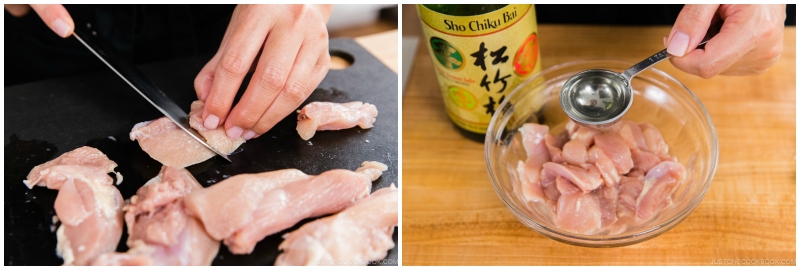
- Thinly slice ½ onion. Next, slice 4 oz cremini mushrooms ¼ inch (6 mm) thick.

To Cook
- Heat a large frying pan over medium heat. (I use a Le Creuset 3.75-QT braiser, which can go directly from oven to table.) When the pan is hot, add 1 Tbsp extra virgin olive oil. Then, add the shrimp to the pan in a single layer.
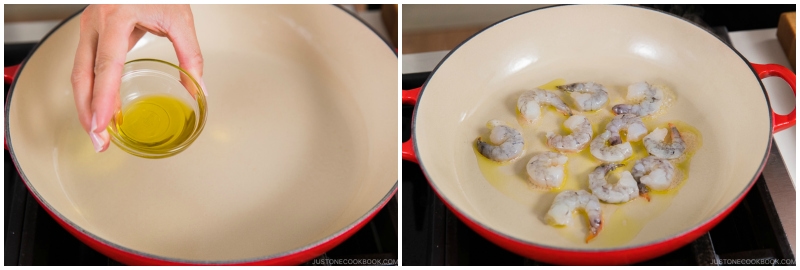
- Season with some Diamond Crystal kosher salt and freshly ground black pepper. Cook until the bottom side changes to an opaque pinkish-white color.

- Flip and cook the other side. When both sides achieve a nice pink color, transfer to a plate. Do not overcook the shrimp; it will continue to cook from the residual heat and finish cooking in the white sauce.
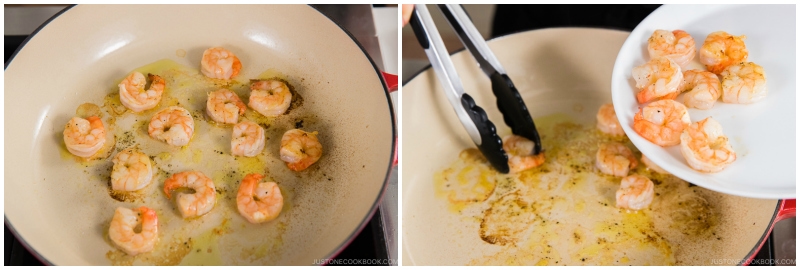
- To the same pan, add ¼ cup unsalted butter and let it melt over medium heat. Do not reduce the amount of butter; you will need this full amount of fat to make enough white sauce for your macaroni. Next, add the onion and sauté until coated with the butter.

- Add the chicken and cook, stirring occasionally, until it‘s no longer pink. Season with more salt and black pepper.

- When the chicken is no longer pink, add the mushrooms and coat with the butter.
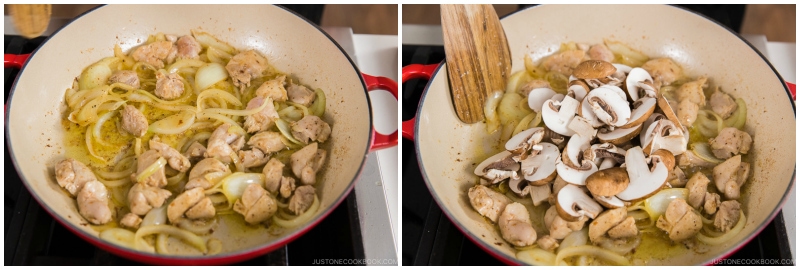
- Add the shrimp back into the pan. Add 1 Tbsp mirin to the mixture and quickly stir into the ingredients.

To Make the White Sauce
- Next, start making the roux for the white sauce: Turn the heat to medium low and add 6 Tbsp all-purpose flour (plain flour) to the mixture, stirring quickly to combine it with the ingredients while scraping the bottom of the pot constantly.

- It‘s important to cook the flour gently during this step to get rid of its raw taste, but don‘t let it toast or turn dark. You want the roux to be a pale color. If the flour on the bottom of the pan starts to brown, reduce or turn off the heat while you finish blending it with the ingredients. Once you‘ve blended the flour well, turn the heat back on and cook for another 2 minutes.

- Then, gradually add ¼ cup of the 2½ cups whole milk. Use your spatula to quickly blend the milk well with the flour mixture. The flour will absorb all the moisture and clump up.

- Continue to add more milk, ¼ cup at a time, stirring quickly after each addition to combine it well with the flour and smooth out any clumps. Make sure there are no lumps of flour left when you‘re done adding all the milk.
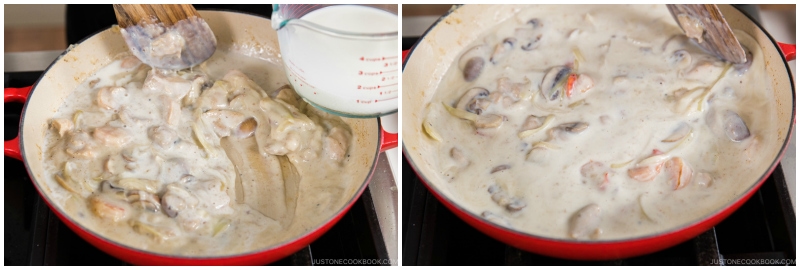
- Once all the milk is incorporated, add ½ cup heavy (whipping) cream and cook for 3–5 minutes, stirring frequently. The mixture will continue to thicken as it cooks.

- At this stage, taste the white sauce and season with 1 tsp Diamond Crystal kosher salt and ½ tsp white pepper powder to taste. Be sure to season it a bit more than you normally would. Remember, you will add in the macaroni later, which will make the sauce taste less salty. Turn off the heat and set aside.
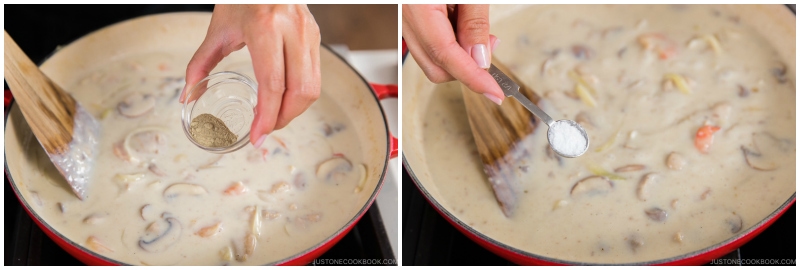
To Cook the Macaroni
- To cook the pasta, bring a pot of water (I use 3 QT water for 8 oz macaroni) to a rolling boil. Stir in 1 Tbsp Diamond Crystal kosher salt. Then, add 8 oz uncooked elbow macaroni and cook according to the package directions until al dente. Drain well.

- Set the pot of white sauce over medium-low heat and add the drained macaroni. Stir well to combine.

To Assemble and Bake
- Preheat the oven to 450ºF (230ºC). For a convection oven, reduce the cooking temperature by 25ºF (15ºC). If you will bake and serve in the oven-safe braiser, you can leave the macaroni mixture in the braiser pan as is. If you are using individual baking dishes, grease them with softened butter. Then, divide the macaroni mixture equally into the individual dishes.

- Fill each individual baking dish (I use 4 Staub 6.5-inch baking dishes) about 90% full.
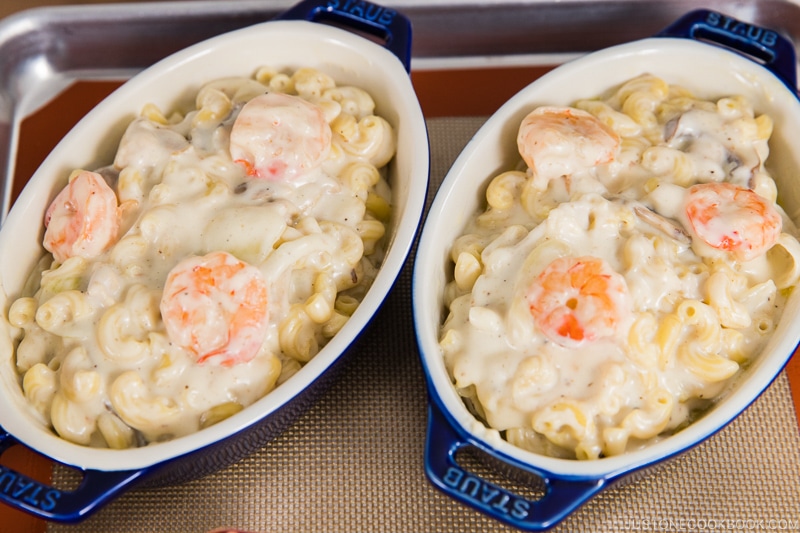
- Grate 2 oz Gruyère cheese and 2 oz Parmigiano-Reggiano or Parmesan cheese and generously sprinkle over the macaroni mixture.

- Sprinkle 3 Tbsp panko (Japanese breadcrumbs) on top of the cheese, a bit less than 1 Tbsp for each individual baking dish. Then, place in the oven and switch to Broil on High for 3–5 minutes (depending on the distance from the heat source), or until golden brown. If you don‘t have a broiler, bake in the preheated 450ºF (230ºC) oven for 15 minutes, or until golden brown.

- When the cheese is melted and the panko is nicely browned and charred, remove from the oven.
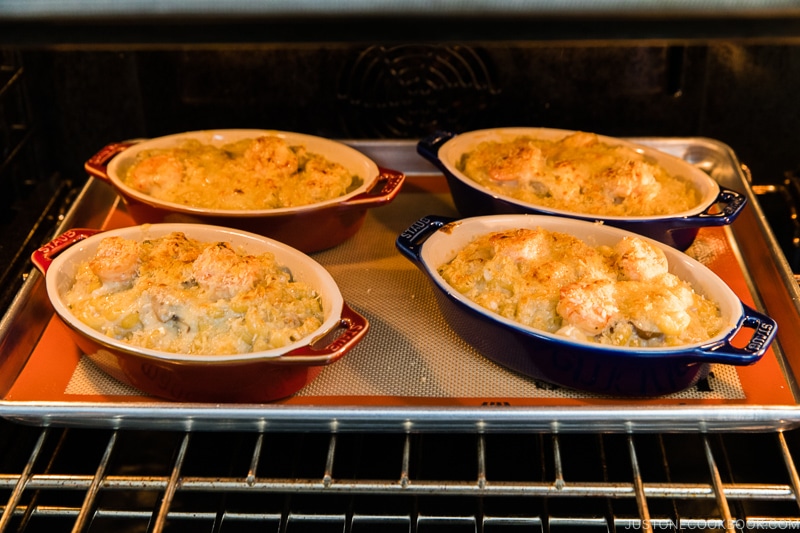
To Serve and Store
- Sprinkle finely chopped chives on top and serve immediately. You can keep the leftovers in an airtight container and store in the refrigerator for up to 3 days and in the freezer for a month.

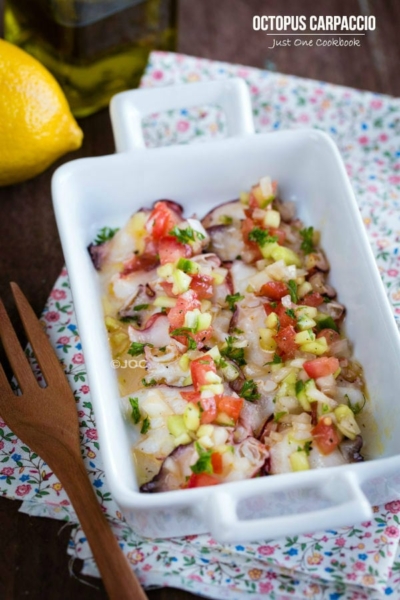







Any suggestions for shrimp substitute? A bit more chicken? My son can’t eat shrimp.
Hello, Alexis. You can omit the shrimp or substitute extra chicken or mushrooms.
We hope you enjoy this dish with your family!
This was delicious! So rich and comforting. Made it exactly as written. I love when you post Yoshoku recipes as it lets me see old familiar dishes in a new and different light.
Hi Andrew! Thank you so much for trying Nami’s recipe and for your kind feedback!
We are so happy to hear you enjoyed Yoshoku recipes (western-style Japanese foods). They are so many of them in our site. We hope you enjoy them all!
https://www.justonecookbook.com/#search/q=yoshoku
Happy Cooking! 😊
We recently moved to Sasebo, Nagasaki so we’ve been wanting to try more Japanese food at home. This was AMAZING! We didn’t have onions or shrimp so we went without those, but this is definitely mine and my husband’s new favorite dish.
Hi Samantha! Thank you very much for reading Nami’s post and trying her recipe!
We are so happy to hear this became a favorite dish! We hope you enjoy many recipes.🥰
I made this with extra chicken sans the shrimp since my wife doesn’t eat it and it came out amazing. This is very simple but oh so good. Brought back memories of my time in Japan.
Hi Ted! We are glad to hear it came out amazing!
Thank you very much for trying Nami’s recipe and sharing your cooking experience with us!
hold off on adding the shrimp back in until just before plating, they are cooked and any more heat will turn them into rubber.
Hi Greg! You can do that, but typically Japanese gratin top is panko/cheese and shrimp is hidden. We only broil it for 3-5 minutes until brown, and it should not overcook the shrimp that much (and I never had any issues personally). But I understand your concern.
Hi Naomi! I’ve tried many of your recipes and it’s been a 100% hit so far with my family so thank you for allowing us to enjoy yummy wholesome home cooked food! Just a simple question – the recipe calls for heavy whipping cream. Is that the same we’d use for strawberry shortcake recipe or just the normal cooking cream will do?
Hi Desk! Thank you very much for trying Nami’s recipe and for your kind feedback!
We are so happy to hear you and your family enjoyed many recipes from our website.
Nami used the same Heavy whipping cream so that the white cream sauce would be thick. However, if you prefer lighter cream, cooking cream works just fine.🙂 Cooking cream contains less fat than heavy cream, and it’s more liquidy and has a light creamy flavor than heavy cream.
We hope this helps!
For many years I’ve been referring to your recipes for Japanese cooking & I love it. I just made this recipe today & omg it’s so yummy! I just had to sub what I didn’t have (like the macaroni, baby Bella mushrooms, & homemade panko) but whatever, still came out perfect! I’m yonsei living in Hawaii but always had to dine at restaurants if I wanted Japanese food but no longer… I’m so grateful to be able to make it myself!
Hi Kelsey! We couldn’t be happier to hear how much joy and excitement Nami’s recipe has brought to you!
Thank you very much for trying Nami’s recipe and for your kind feedback!
I love so many of the recipes on your site, Nami, but this one has to be my favorite:) Thank you for posting so many wonderful recipes!
Hi Lauren, Yay! We are glad to hear this has become one of your favorite. Thank you very much for trying this recipe and for your kind feedback!
Nami-san,
Konichiwa! My mother was Japanese and our family lived in Japan until I was 14 years old. I am very “natsukashi” for many Japanese dishes. Like you, Macaroni Gratin was one of my favorites. I’m so glad to have found this recipe because the macaroni & cheese here is not the same! This is exactly the way I remembered it!
BTW, when I was in Japan a couple of years ago, I tried to find a restaurant that served Macaroni Gratin, but couldn’t find any. I was at Shijuku Eki and looked at many coffee shop menus. Have you been able to find it lately? Or was I looking at the wrong type of restaurant?
Hi Rita! Macaroni Gratin is found at Yoshoku restaurants, so the easiest place would be pasta restaurants, cafes, hambagu restaurants, oh not to mention Family Restaurants (ファミレス)! Anywhere that serves western-style dishes. Kids’ favorite, so typical western (non-authentic Italian) restaurants serve it too. Coffee shops probably not, because they go for sandwich etc, lighter meal. 🙂
Wow Nami,
Your Recipes are so beautiful, so full of flavor, and so full of Love which is truly the main ingredient. It is so humbling that you bring so many people into your cooking family with the truly treasured recipes you came to know & love as you grew up! I thank your mother for an amazing Job in your upbringing!
Hi Nannette! Thank you for your kind words and encouragement. They meant so much to me. Thank you!!!
Thanks Nami for sharing this recipe! I did not have the pan or individual baking dish. So I simply transfer it to a big baking dish and it turned out just great!
Love the panko cheese top…so yummy and addictive. This is gonna be the way I am gonna make gratin or baked mac/rice dishes the next time.
And yes to smooth velvety white sauce! 😋
Hi Debbie! I’m so glad you enjoyed this dish and thanks for trying my recipe. I love the panko and cheese crusty top… I need to make this again. 😀 Thank you for your kind feedback!
Don’t have either one of those dishes that you mentioned to make it in. Would a cast iron skillet work too?
Hi Joyce! Sure, that will work too, or transfer the macaroni and sauce into a 8×8 baking dish. I’ll mention the size in the recipe. Thanks for bringing to my attention! 🙂
It is as if you heard my call out to the universe… I’ve been searching for a Japanese macaroni gratin recipe for the last week.
I lived on Okinawa for 23 years and have lately (and once again) been missing the people, their sensibilities, the culture and the macaroni gratin I often ate in a Yoshoku called “Sometime” in Awase.
Like you I searched and searched but never found a true Japanese version until yours so…THANK YOU.
Thank you for ending my search but also for all the delicious authentic dishes you post for people to discover that haven’t been as lucky as I
Hi Joan! I hope you enjoy this recipe. It’s a pretty classic recipe, and there is no twist to this recipe (so feel free to change up as you like). I am happy to hear you got to eat macaroni gratin in Japan. I also feel very nostalgic when I make and eat this dish. And I’m happy to hear you had a great time living in Okinawa for 23 years! Wow, that’s a long time. I only have a few Okinawan recipes here, and I hope to go back to Okinawa again and taste new food to create at home. 🙂